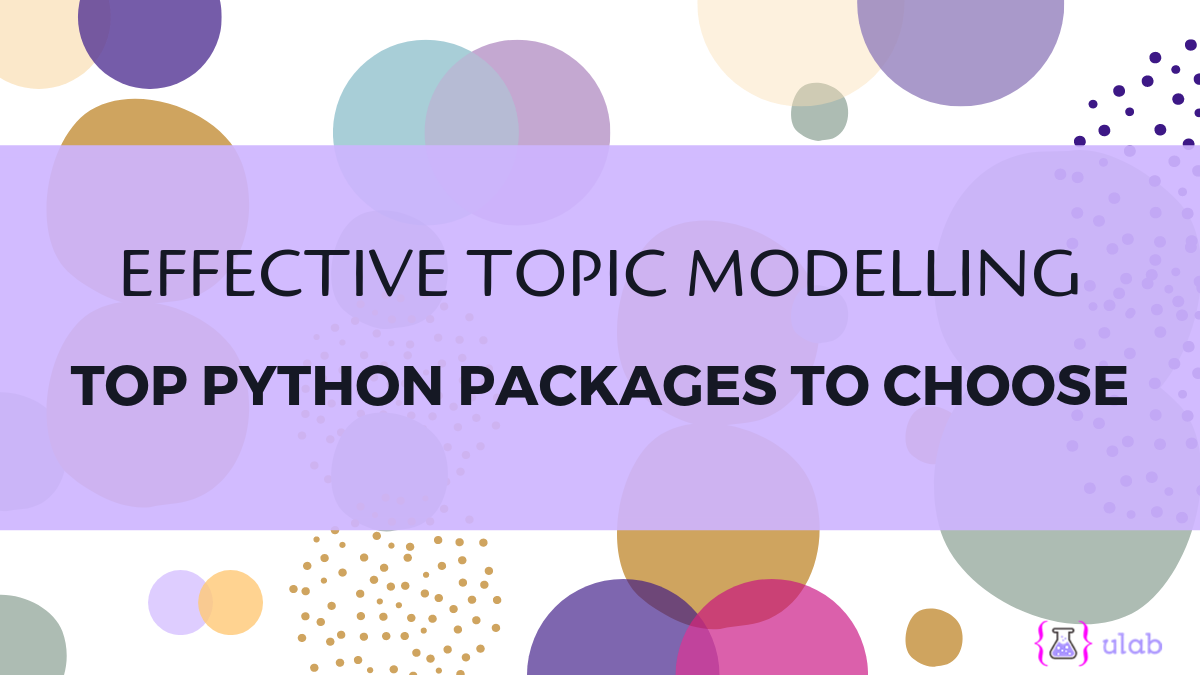EFFECTIVE TOPIC MODELING: Top Python Packages to Choose

The world is being highly accustomed to online channels now. Within that, as the social media channels, especially, Facebook, Twitter, Instagram and YouTube, are prompting users to share content every minute, the daily online content sharing amounts to more than 45 billion, worldwide.
So, the data is huge, but finding a meaning behind the data piles needs a smart automation and modelling. Not just the individuals but also enterprises may still be jostling to find effective data mining techniques to business intelligence.
Python packages have come a long way in empowering engineers analyse that data or rather text, to gather meaningful insights.
There are various techniques for topic modeling – the process of identifying which topic is being discussed prominently in a given document or data pile. Latent Dirichlet Allocation (LDA), Natural Language (NLP), Hierarchical Dirichlet Process and Latent Semantic Analysis, etc.
If you have been on a lookout for some effective sources for topic modelling too, you need to choose from the list of top Python packages, so that you find patterns behind those huge sources of text and content, effectively. You’ve found us rightly, and this is what we’ve got for you:
1. NLTK
This is a natural language toolkit used for tokenization, parsing, POS tagging etc. Other key features available in the library of toolkit include options for stemming, lemmatization. Regarded as an effective tool for teaching and training in computational linguistics in Python, NLTK provides a hand to hand guide for new learners as well as seasoned engineers. In addition to covering the basics, NLTK also takes you through some of the most advanced features and merits of NLP.
Download here: http://www.nltk.org/
2. Spacy
A powerful alternative to NLTK, Spacy is another Topic Modelling Python package, offering some of the most effective programming features. It helps organize and leverage unstructured data existing in any of the forms – video, audio, or even written transcripts. The sources for these data piles could be an email, a hand-picked document or even a social media channel. The package is smart enough to identify the data beneath the channels.
Download here: https://spacy.io/ , radimrehurek.com
3. Scikit-Learn
This is a purely machine learning based package allowing pre-processing of all data. One of the simplest data mining and analysis tools, Scikit-Learn offers reusability in context and is built on NumPy. It is an open source tool offering a licensed usage. It offers classification, model selection, regression and dimension reduction in data.
Download here: https://scikit-learn.org/stable/
4. Gensim
An LDA-based package, Gensim works by segregating meaningful, strategic patterns from data sources. It can work effectively to help enterprises find common patterns behind customer reviews, feedbacks, news stories or even internal complaints and requests. So, instead of struggling read and re-read multiple content, or watch videos etc to relate them, you can depend on this package to derive quick insights.
Download here: https://radimrehurek.com/gensim/, github.com
5.Ployglot
If you are fan of language learning alongside engineering, polyglot will supersede the others. Instead of confining to just the package or tool, it rather offers a complete community of learning and exchange. So, you are at an edge over others in your room in terms of language and data processing.
Download here: https://polyglotclub.com/
6. pyLDAvis
This is another one designed in a tailor-made fashion to help users find meaning out of huge data corpus. pyLDAvis works on the LDA model and provides effective visualization.
Download here: https://pypi.python.org/pypi/pyLDAvis/2.1.1, https://pypi.org/
Together each of these Python based packages provide several third-party extensions, fast sentence tokenization, multiple language processing, comprehensive learning for beginners, in-built word vectors and object-oriented resources. In addition, they work through large sized datasets and data streams and hence, propel deep learning. They also allow part of speech tagging techniques, sentiment analysis, vector space modeling as well as clustering.
Some Critical Steps for Effective Topic Modeling
- Load libraries for a single visualization so that nothing is missed out.
- Read all text files carefully and then identify the quotes, extra spaces etc.
- Then comes the token creation. We remove all punctuations here.
- Stem the tokens to the root form.
- Then comes the turn of assigning frequency matrix.
Now your data is ready for the input into the package.
Taking the First Feet
Topic modeling is fast emerging as one of the most favourite topics for AI engineers as any use case in the field can turn dumped data into an effective business strategy. Enterprises who race against time to make these a reality in their respective fabrics will much likely lead a disruption.
It is high time we all realise the power of data analytics and begin to leverage it for better business intelligence.
Once you start off, it is important to import the text to minimize misled results. Creating a test document is a good idea too to minimize this pitfall and this also covers up for any inaccurate classification of data. You can easily place the text into different buckets in case your data is just too scattered.
You need to also filter out any numbers from the token because they rarely make any sense. For an even effective result, you can use lemmatization for converting each of the word into its root form so that sampling and modeling happens effectively. This is an automated technique and helps save your time during the inputting.
References for further reading:
Tutorials:
https://ourcodingclub.github.io/2018/12/10/topic-modelling-python.html
https://towardsdatascience.com/topic-modelling-in-python-with-nltk-and-gensim-4ef03213cd21to
Articles:
Ebook:
Click to access Building-Machine-Learning-Systems-Python-ebook%20(1).pdf
Summing Up
We’re now living in a world full of innovation and automation. When an intelligence machine or application can do it for you, you are freed up for more strategic work. So, your human intelligence acts on top of what the automation technique brings out to you. Leverage the packages above to power up your data analytics.
However, topic modelling, as a subject, finds lesser number of use cases at present.One prominent reason for that is the tools demand a high degree of preparation. Even though they promise automation, alot of mannual inputs are still needed before the mining begins.
Yet, with the advent and mainstreaming of tools and packages like these, this practice is soon going to become a must-have for enterprises. The sources of data, as discussed earlier in this blog, are multiple and ever-growing. However, we’re all short of time and efficiency to study them. Artificial intelligence and Machine learning are revolutionising the industry.
If you would like to add anything, your comments and suggestions are welcome. If you have questions, rather, we’d be glad to address them. Connect with us through the comments section below.

